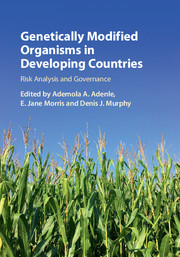53 results
Index
-
- Book:
- Genetically Modified Organisms in Developing Countries
- Published online:
- 05 July 2017
- Print publication:
- 09 June 2017, pp 301-306
-
- Chapter
- Export citation
1 - Introduction
-
-
- Book:
- Genetically Modified Organisms in Developing Countries
- Published online:
- 05 July 2017
- Print publication:
- 09 June 2017, pp 1-10
-
- Chapter
- Export citation
2 - Recent Scientific Developments in Genetic Technologies: Implications for Future Regulation of GMOs in Developing Countries
- from Part I - Risk Analysis Methodology and Decision-Making
-
-
- Book:
- Genetically Modified Organisms in Developing Countries
- Published online:
- 05 July 2017
- Print publication:
- 09 June 2017, pp 13-25
-
- Chapter
- Export citation
Part I - Risk Analysis Methodology and Decision-Making
-
- Book:
- Genetically Modified Organisms in Developing Countries
- Published online:
- 05 July 2017
- Print publication:
- 09 June 2017, pp 11-88
-
- Chapter
- Export citation
Foreword
-
- Book:
- Genetically Modified Organisms in Developing Countries
- Published online:
- 05 July 2017
- Print publication:
- 09 June 2017, pp xiii-xvi
-
- Chapter
- Export citation
25 - Conclusions and Recommendations
- from Part IV - Case Studies from Developing Countries
-
-
- Book:
- Genetically Modified Organisms in Developing Countries
- Published online:
- 05 July 2017
- Print publication:
- 09 June 2017, pp 294-300
-
- Chapter
- Export citation
Copyright page
-
- Book:
- Genetically Modified Organisms in Developing Countries
- Published online:
- 05 July 2017
- Print publication:
- 09 June 2017, pp iv-iv
-
- Chapter
- Export citation
Contents
-
- Book:
- Genetically Modified Organisms in Developing Countries
- Published online:
- 05 July 2017
- Print publication:
- 09 June 2017, pp v-vii
-
- Chapter
- Export citation

Genetically Modified Organisms in Developing Countries
- Risk Analysis and Governance
-
- Published online:
- 05 July 2017
- Print publication:
- 09 June 2017
Part III - Risk-Analysis-Based Regulatory Systems
-
- Book:
- Genetically Modified Organisms in Developing Countries
- Published online:
- 05 July 2017
- Print publication:
- 09 June 2017, pp 151-212
-
- Chapter
- Export citation
Part IV - Case Studies from Developing Countries
-
- Book:
- Genetically Modified Organisms in Developing Countries
- Published online:
- 05 July 2017
- Print publication:
- 09 June 2017, pp 213-300
-
- Chapter
- Export citation
Contributors
-
- Book:
- Genetically Modified Organisms in Developing Countries
- Published online:
- 05 July 2017
- Print publication:
- 09 June 2017, pp viii-xii
-
- Chapter
- Export citation
Part II - Diversification of Expertise
-
- Book:
- Genetically Modified Organisms in Developing Countries
- Published online:
- 05 July 2017
- Print publication:
- 09 June 2017, pp 89-150
-
- Chapter
- Export citation
Contributors
-
-
- Book:
- The Cambridge Dictionary of Philosophy
- Published online:
- 05 August 2015
- Print publication:
- 27 April 2015, pp ix-xxx
-
- Chapter
- Export citation
Clinical and Biochemical Heterogeneity in an Italian Family with CPT II Deficiency due to Ser 113 Leu Mutation
-
- Journal:
- Canadian Journal of Neurological Sciences / Volume 32 / Issue 3 / August 2005
- Published online by Cambridge University Press:
- 02 December 2014, pp. 316-320
-
- Article
-
- You have access
- Export citation
Lymphocyte numbers in endogenous depression
-
- Journal:
- Psychological Medicine / Volume 17 / Issue 2 / May 1987
- Published online by Cambridge University Press:
- 09 July 2009, pp. 381-385
-
- Article
- Export citation
Phytochemistry and Agriculture, eds T. A. Van Beek & H. Breteler. xxv + 390 pp. Oxford: Oxford University Press (1993). £60.00 (hardback). ISBN0 19 857762 1.
-
- Journal:
- The Journal of Agricultural Science / Volume 123 / Issue 2 / October 1994
- Published online by Cambridge University Press:
- 27 March 2009, pp. 297-298
-
- Article
- Export citation
Storage lipid formation in seeds
-
- Journal:
- Seed Science Research / Volume 3 / Issue 2 / June 1993
- Published online by Cambridge University Press:
- 19 September 2008, pp. 79-95
-
- Article
- Export citation
15 - The roles of management, subsidies and breeding in crop improvement
-
-
- Book:
- Plant Breeding and Biotechnology
- Published online:
- 07 May 2010
- Print publication:
- 28 August 2007, pp 226-238
-
- Chapter
- Export citation
9 - Decline of the public sector
-
-
- Book:
- Plant Breeding and Biotechnology
- Published online:
- 07 May 2010
- Print publication:
- 28 August 2007, pp 126-136
-
- Chapter
- Export citation

